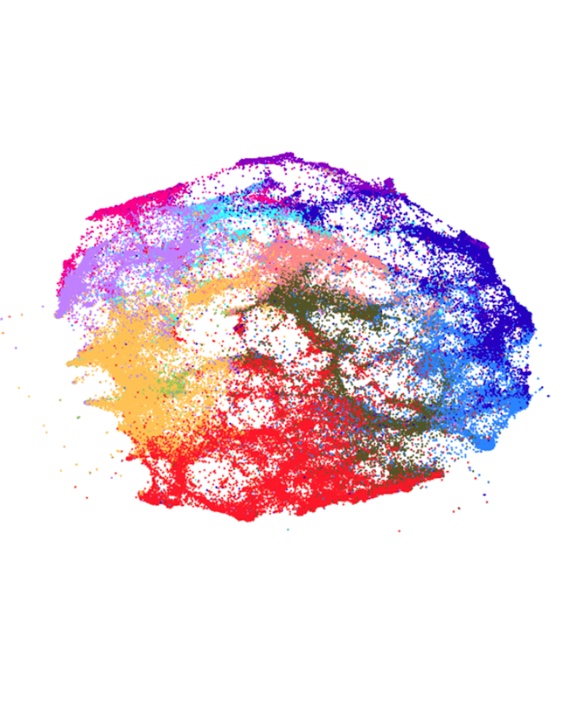Having developed a map of science––a visual representation of research clusters of scientific publications––and after assigning measures of AI-relevance, we can now explore the concentration of AI-related publications in RCs across all of science. For this analysis, we use the same set of filtered RCs1 described in Creating a Map of Science and Measuring the Role of AI in it and compare AI research across the 11 broad research areas. This analysis allows us to define the level of AI presence in different RCs from all areas of science.
We group RCs into seven bins using the percentage of AI-related papers in that cluster:2 [0%], (0%-5%], (5%-10%], (10%-25%], (25%-50%], (50%-75%], (75%-100%]. Forty-seven percent of all filtered RCs have at least one AI-related paper, with the majority of those RCs (72 percent) falling in the 0%-5% AI-related papers bin. Figure 1 displays the distribution of RCs based on their percentage of AI-related papers and broad research area. We see the clear relationship between AI-related papers and computer science—99 percent of RCs in the 75%-100% AI-related papers bin are computer science RCs.
Figure 1. Distribution of RCs by AI-related papers and research areas

We find that the 10%-25% AI-related papers bin is the first to reach majority computer science RCs (59 percent) while still including a sizable number of RCs (41 percent) from all other broad research areas.
While it may be clear that RCs with 0% AI-related papers have no AI presence and RCs with 75%-100% AI-related papers have the most AI presence, the role of AI in RCs in the five bins in the middle is less obvious. Understanding that AI is a computer science area of research, we consider the percentage of computer science RCs in each AI-related papers bin as an indicator of how restrictive that threshold may be to cross-disciplinary research (see Table 1). We find that the 10%-25% AI-related papers bin is the first to reach majority computer science RCs (59 percent) while still including a sizable number of RCs (41 percent) from all other broad research areas.
Table 1. Percentage of computer science RCs in each AI-related papers bin
| AI-related Papers | 0% | 0%-5% | 5%-10% | 10%-25% | 25%-50% | 50%-75% | 75%-100% |
| Percentage of Computer Science RCs | 2% | 10% | 40% | 59% | 82% | 95% | 99% |
There is a steady increase in computer science RCs and decrease in other research area RCs over the 25%-50%, 50%-75%, and 75%-100% AI-related papers bins. In the 25%-50% AI-related papers bin, computer science RCs are dominant, but all research areas except for chemistry still appear. Moving to the 50%-75% AI-related papers bin, only five non-computer science research areas (earth science, engineering, mathematics, medicine, and social science) are represented. Finally, in the 75%-100% AI-related papers bin, all but four mathematics RCs are computer science.
We assign the following labels to RCs according to their AI-related papers bin:
- 0%: No AI research
- 0%-5% and 5%-10%: Limited contribution of AI research
- 10%-25%: Cross-disciplinary AI research
- 25%-50%: Cross-disciplinary research with significant AI contributions
- 50%-75% and 75%-100%: Advanced AI research
To provide insight into cross-disciplinary research that leverages an increasing amount of AI, we provide examples of non-computer science RCs in the 10%-25%, 25%-50%, 50%-75%, and 75%-100% AI-related papers bins. For these examples, we choose the RC in each bin with the highest average three-year growth (2017–2020) from a non-computer science research area.
10%-25% AI-related papers bin: RC 118504 is labeled as social science and its publications analyze features that dictate how marketing affects consumer choice. This RC is 17 years old, with 245 publications and an average three-year growth of 180 percent.
25%-50% AI-related papers bin: RC 65835 is an engineering RC that is centered around adaptive learning that incorporates AI instruction for engineering and accounting educational instruction. This RC is four years old, with 2,712 publications and an average three-year growth of 83 percent.
50%-75% AI-related papers bin: RC 65590 falls under the broad research area of medicine and focuses on using convolutional neural network image classification for skin cancer detection. This RC is three years old, with 755 publications and an average three-year growth of 85 percent.
75%-100% AI-related papers bin: RC 55853 is the highest growing mathematics RC in this bin that concentrates on robust estimators for algorithmic optimization (e.g., the sum of squares). This RC is seven years old, with 561 publications and an average three-year growth of 35 percent.
This work provides us with a deeper understanding of how AI-related publications are distributed across RCs, as well as what AI-related publication percentages are useful to use as a filter given the research question at hand.
In August 2021, CSET updated the Map of Science, linking more data to the research clusters and implementing a more stable clustering method. With this update, research clusters were assigned new IDs, so the cluster IDs reported in this Snapshot will not match IDs in the current Map of Science user interface. If you are interested in knowing which clusters in the updated Map are most similar to those reported here, or have general questions about our methodology or want to discuss this research, you can email cset@georgetown.edu.
Download Related Data Brief
Comparing the United States’ and China’s Leading Roles in the Landscape of Science- We filter RCs based on two criteria: 1) RCs where 50 percent or more of the papers in that cluster were successfully assigned an AI (or not AI) label and 2) RCs with an “age” of 20 years or less.
- Details on assigning AI-related publication percentages can be found here: https://cset.georgetown.edu/publication/creating-a-map-of-science-and-measuring-the-role-of-ai-in-it/.
